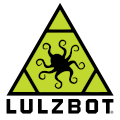
Open HardwareAssembly Instructions
Guides for installation and assembly of the LulzBot line of products made by FAME 3D LLC.

Guides for installation and assembly of the LulzBot line of products made by FAME 3D LLC.
Using your 2.5mm driver, unscrew the two M3 screws that secure the connector cover on the X axis carriage.
Using the scissors, cut the two zip ties that secure the harness to the carriage.
Lift the connector away from the X axis carriage.
Unplug the tool head connector from the wiring harness.
The tool head is attached with three screws. The print surface can be damaged if the tool head is allowed to fall onto the print surface.
With one hand, support the tool head.
Using the 4mm driver, unscrew the three M5 screws securing the tool head to the X axis carriage.
Remove the bottom screw first, followed by the remaining two screws.
Remove the tool head from the printer by lifting the tool head away from the printer.
Press the Flexystruder onto the X axis carriage, aligning the tab with the cutout on the back of the new tool head.
Secure it to the X axis carriage by loosely screwing in the top two screws.
Leave the top two screws loose.
Install the last screw into the bottom of the X axis carriage and fully tighten.
Tighten the top two screws.
Connect the two 16 pin connectors, making sure to match them based on the pins in the connector.
Secure the tool head wiring harness to the X axis carriage with 2 zip ties. Trim off the excess from each zip tie.
Cura LulzBot Edition is available from:
Install Cura LulzBot Edition if not already installed on your computer.
If Cura has already been installed, update to the latest version, as it has preset machine configuration profiles.
Plug in your LulzBot Mini 3D printer to the power supply and power on your 3D printer.
Once powered on, connect your 3D printer to your computer using the USB cable.
Open Cura LulzBot Edition.
Press the Finish button to exit the tool head wizard.
In order to get the best performance from your Flexystruder Tool Head v2, update the extruder steps per unit (or e-steps) with the recorded value found on your Flexystruder, recorded in step 8.
Enter your E-Step value to the field labeled "E-Steps per 1mm of filament"
Click Ok to save these settings.
In Cura LulzBot Edition, load the key chain test print. The model can be downloaded here:
Locate the included glue stick.
SemiFlex and NinjaFlex will adhere exceedingly well to the print surface. To aid part removal, evenly apply glue stick to the print surface.
Failure to do so may cause the printed flexible part to bond permanently to the PEI print surface.
Press the Control button to open the Printer Interface window.
SemiFlex and NinjaFlex will adhere exceedingly well to the print surface. To aid part removal, evenly apply glue stick to the print surface.
Failure to do so may cause the printed flexible part to bond permanently to the PEI print surface.
Turn on the hot end by setting the extrusion temperature to 220°C.
You are almost ready to print!
Your Flexystruder tool head was calibrated before leaving our factory. Once the printer is up to extrusion temperature remove the filament.
In Cura, press the Retract 10 button as needed to remove the filament from the hot end.
Remove the filament from the extruder.
Load the NinjaFlex filament sample into the extruder body.
Press the Motors off button.
Slowly rotate the large gear by hand, counter-clockwise, to feed the filament into the hot end.
Once your 3D printer is at the appropriate extrusion temperature of 220°C, finish loading the filament by rotating the large gear counter-clockwise until the extruded filament underneath the hot end nozzle transitions to LulzBot green.
Press Print!
Your LulzBot Mini 3D printer will automatically do the following:
After the key chain has been printed the tool head will move away from the completed model. The bed will move forward once the printer cools to the recommended part removal temperature.
Remove your printed object by using the blue-handled pry tool to lift the part from the bed.
To switch back to the original tool head, follow the same steps outlined in this guide, except this time, select the Standard LulzBot Mini tool head and options.
Have questions, or ideas? Share them with community by joining our user forum at Forum.LulzBot.com